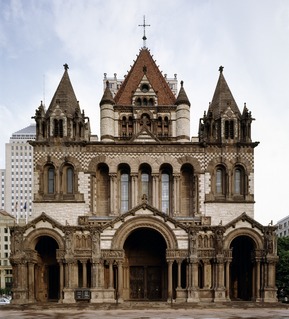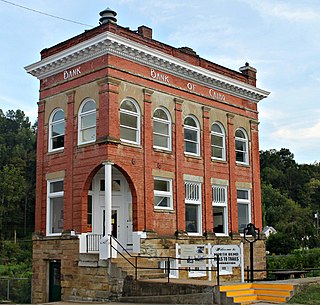
Richardsonian Romanesque is a style of Romanesque Revival architecture named after the architect Henry Hobson Richardson (1838–1886). The revival style incorporates 11th and 12th century southern French, Spanish, and Italian Romanesque characteristics. Richardson first used elements of the style in his Richardson Olmsted Complex in Buffalo, New York, designed in 1870. Multiple architects followed in this style in the late 1800s; Richardsonian Romanesque later influenced modern styles of architecture as well.

William Bunker Tubby was an American architect who was particularly notable for his work in New York City.

The First National Bank Building, also known as the First National Building, is a Romanesque Revival building in Ann Arbor, Michigan designed by the local architectural firm of Fry and Kasurin. It stands at 201-205 South Main Street in downtown Ann Arbor. The building was added to the National Register of Historic Places on November 24, 1982.

The Oregon Commercial Historic District is a historic district in Oregon, Illinois, that has been listed on the National Register of Historic Places since 2006. The district is roughly bordered by Jefferson, Franklin, 5th and 3rd Streets in Oregon. It is one of six Oregon sites listed on the National Register and one of three to be so listed since the turn of the 21st century. The other two are the Oregon Public Library, listed in 2003, and the Chana School, listed in 2005.

The Bank of Bigheart is a historic commercial building in the town of Barnsdall, Oklahoma. It originally housed the first bank in Barnsdall, which was originally named Bigheart, Oklahoma. The building was added to the National Register of Historic Places on November 23, 1984.

The Bank of Burbank is a historic bank building in Burbank, Oklahoma. It was built in 1910, operated through the Great Depression, and continued in business until 1948, when the bank ceased operating. The building was used for a while as the Burbank post office, and subsequently was renovated for use as a private residence.

The Merchants National Bank or Brooks Building is a commercial building in Saint Paul, Minnesota, United States, built and opened in 1892 as a financial center in St. Paul's Lowertown neighborhood at the corner of Jackson Street and Fifth Street. The structure, designed by Edward Bassford, uses sandstone in a Richardsonian Romanesque style. The ground floor was occupied by an influential bank, while the upper stories provided law offices. Several office tenants went on to great state or national prominence, including Cushman Kellogg Davis, Cordenio Severance, Frank B. Kellogg, Pierce Butler, and William D. Mitchell. For many years, the building was known as the McColl Building. It is listed on the National Register of Historic Places. The four-story structure was carefully rehabilitated and restored by David A. Brooks, and the building now carries his family name.

Lehigh Valley Railroad Station is a historic railway station located at 806 West Buffalo Street, Ithaca in Tompkins County, New York.

The Ashbel Smith Building, also known as Old Red, is a Romanesque Revival building located in Galveston, Texas. It was built in 1891 with red brick and sandstone. Nicholas J. Clayton was the architect. It was the first University of Texas Medical Branch building.

The American Security and Trust Company Building is a Neoclassical bank office in Washington, D.C., designed by the architectural firm of York and Sawyer. It was listed on the National Register of Historic Places in 1973.

The Washington County Courthouse in Washington, Iowa, United States, was built in 1887. It was individually listed on the National Register of Historic Places in 1981 as a part of the County Courthouses in Iowa Thematic Resource. In 2013 it was included as a contributing property in the Washington Downtown Historic District. The courthouse is the third building the county has used for court functions and county administration.

The Fayetteville Historic Square, in Fayetteville, Arkansas, includes the original Fayetteville post office, the Old Bank of Fayetteville Building, the Lewis Brothers Building, the Mrs. Young Building, and the Guisinger Building. These buildings are listed in the National Register of Historic Places. There are several more recent buildings located on the Square.

Bank of Cairo, now known as Cairo Town Hall, is a historic bank building located at Cairo, Ritchie County, West Virginia. It was built in 1897, and is a 2+1⁄2-story brick structure with Romanesque and neoclassical details. It features a unique corner entrance. It housed a bank founded by Jacob Cattaui, the son of a wealthy Egyptian banker and cotton plantation owner in 1897. The bank was housed in the same building since its inception in 1897 to 1931 and from 1941 to 1974. It now houses the Cairo Town Hall and serves as a stop on the North Bend Rail Trail.

James G. Hill (1841–1913) was an American architect who, during the period 1876 to 1883, headed the Office of the Supervising Architect of the United States Department of the Treasury, which oversaw major Federal buildings.

The Riggs National Bank, Washington Loan And Trust Company Branch, also known as Washington Loan and Trust, is a historic building in Washington, D.C.. It currently serves as a hotel.

The Eight Hundred Block of F Street NW refers to a collection of five commercial buildings in the Penn Quarter neighborhood of Washington, DC. It currently houses the International Spy Museum and is across the street from the Smithsonian American Art Museum. It also houses a branch of the Shake Shack.

West Washington Historic District is a national historic district located at South Bend, St. Joseph County, Indiana. It encompasses 330 contributing buildings in an upper class residential section of South Bend. It developed between about 1854 and 1910, and includes notable examples of Italianate, Greek Revival, and Romanesque Revival style architecture. Located in the district are the separately listed Morey-Lampert House, Oliver Mansion designed by Lamb and Rich, Second St. Joseph County Courthouse, South Bend Remedy Company Building, and Tippecanoe Place. Other notable buildings include the Bartlett House (1850), Birdsell House (1897), DeRhodes House designed by Frank Lloyd Wright, Holley House, Kaiser-Schmidt House, Listenberger-Nemeth House, Meahger-Daughterty House (1884), O'Brien House, Oren House, The People's Church (1889), St. Hedwig's Church, St. Patrick's Church (1886), St. Paul's Memorial United Methodist Church (1901), West House, and a row of worker's houses.

The Chelsea Village Historic District encompasses the historic village center of Chelsea, Vermont, the shire town of Orange County. Developed in the first half of the 19th century as a regional service and transportation hub, the village exhibits a significant number of Greek Revival buildings, augmented with primarily later civic and commercial buildings. It was listed on the National Register of Historic Places in 1983.

The Railroad Street Historic District encompasses a cluster of commercial and railroad-related buildings at the traditional late 19th-century heart of St. Johnsbury, Vermont. It includes five commercial buildings and the town's 1883 union depot, and is reflective of the town's importance as a major railroad junction in northern New England. The district was listed on the National Register of Historic Places in 1974. It was subsumed by the larger St. Johnsbury Historic District in 1980.

The Farmers and Mechanics Bank is a historic building in the Georgetown neighborhood of Washington, D.C. Constructed between 1921 and 1922, the bank was first the headquarters of the Farmers and Mechanics National Bank. Soon thereafter, it became known as the Farmers and Mechanics Branch of Riggs National Bank. In 2005, the building became a branch of PNC bank.























